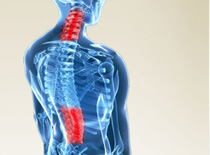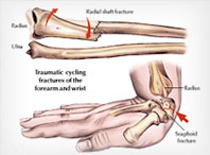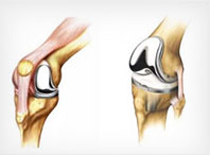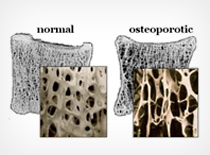Fractures and Sports Injuries
:: Fracture ::

A fracture, also referred to as a Bone fracture, FRX,FX, Fx or #, is a medical condition where the continuity of the bone is broken.
A significant percentage of bone fractures occur because of high force impact or stress; however, a fracture may also be the resultof some medical conditions which weaken the bones, for example osteoporosis, some cancers or osteogenesis imperfecta. A fracture caused by a medical condition is known as a pathological fracture.
The word break is commonly used by lay (non-professional) people.
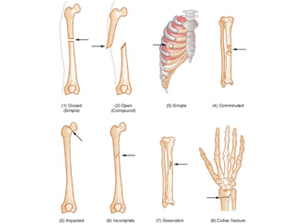
There are several different ways in which a bone can fracture; for example a clean break to the bone that does not damage surrounding tissue or tear through the skin is known as a closed fracture or a simple fracture. On the other hand, one that damages surrounding skin or tissue is known as a compound fracture or an open fracture. Compound or open fractures are generally more serious than simple fractures, with a much higher risk of infection.
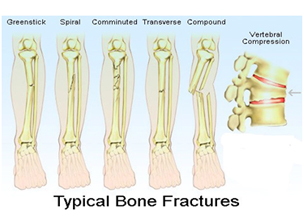
The period immediately after a bone fracture is critical for the proper repair of the bone and healing of the affected tissues. Bones begin to heal very quickly after a fracture and the bone tissue will knit together with any nearby bone fragments to form a callus of cartilage and eventually new bone tissue.
The ultimate goal of bone healing is to reach a proper union of the fractured bone pieces that restores the original bone anatomy and restores full function to the muscles and joints that move the bone.
What causes fractures?

Your bones are some of the strongest tissues in your body. If an impact or a force is stronger than the strength of the bone on which it is acting, then a fracture may result. The most common causes of fracture are falls, motor vehicle accidents, and a weakening of the bone called osteoporosis.
What are the risk factors for fractures?

A number of factors increase the risk of developing fractures. Not all people with risk factors will get fractures. Risk factors for fractures include:
» Advanced age
» Certain genetic disorders
» Excessive tobacco or alcohol consumption
» Female gender(Post Menopausal)
» Lack of physical activity on a regular basis
» Lack of proper nutrition, especially calcium
» Osteoporosis (thinning and weakening of the bones)
» Participation in sports
» Thyroid or endocrine disorders
» Vitamin deficiencies
What are the symptoms of fractures?

Symptoms of fractures commonly include pain, swelling, bruising, and a change of shape at the surface of the skin due to the protrusion of a bone in the affected region. More rarely, a fracture can break through your skin, resulting in bone protruding from a wound.
You may experience fracture symptoms immediately after an injury, while sometimes it may take more time for symptoms to appear.
Common symptoms of a fracture include:
» Bleeding
» Deformity
» Inability to move a joint
» Numbness and tingling in the affected region
» Pain
» Redness and warmth
» Swelling
In some cases, fractures can be life threatening. Seek immediate medical care if you, or someone you are with, have any of these life-threatening symptoms:
» Bone protruding through the skin
» Confusion or loss of consciousness for even a brief moment
» Profuse bleeding
» Suspected fracture of the neck, back, skull, pelvis, hips or femur
» Vision changes or loss
When to call the doctor?

A physician should be called when an adult or child complains of bone pain. This is a deep pain that may be exquisitely tender to the touch.
» Diagnosis : Diagnosis begins immediately with an individual's own observation of symptoms.
A thorough medical history and physical exam by a physician often reveals the presence of a fracture. An x ray of the injured area is the most common test used to determine the presence of a bone fracture
Any x-ray series performed involves at least two views of the area to confirm the presence of the fracture because not all fractures are apparent on a single x ray.
Some fractures are often difficult to see and may require several views at different angles to see clear fracture lines. In some cases, CT, MRI, or other imaging tests are required to demonstrate fracture.
What you can do to improve your fracture?

Your doctor almost always must treat a fracture. The way you treat a fracture immediately after it happens and before you can get to a hospital is important. You can improve the outcome of your fracture by following these rules:
First aid is the appropriate initial treatment in emergency situations. It includes proper splinting, control of blood loss, and monitoring vital signs such as breathing and circulation.
» Apply ice to a fracture to reduce swelling
» Prevent any movement of a victim if a head, neck, or back fracture is suspected
» Try to immobilize the broken bone if a person must be moved or carried to safety
Immobilization of a fracture site can be done internally or externally. The primary goal of immobilization is to maintain the realignment of a bone long enough for healing to start and progress. Immobilization by external fixation uses splints, casts, or braces.
How are fractures treated?

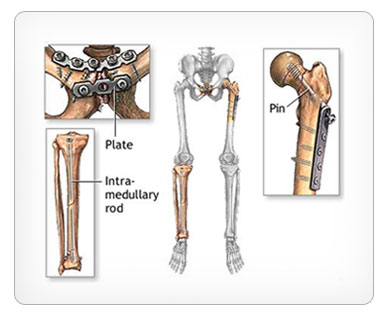
Treatment depends on the type of fracture, its severity, the individual's age, and the person's general health. The first priority in treating any fracture is to address the entire medical status of the patient.
First aid is the appropriate initial treatment in emergency situations. It includes proper splinting, control of blood loss, and monitoring vital signs such as breathing and circulation.
Fractures are treated in a variety of ways. The intention of most treatments is to realign the fractured bones in their original orientation and then to eliminate movement so the bones can heal. Realignment of the bone pieces in a fracture is known as Reduction of the fracture.
Treatment can vary from using ice and pain relievers (for a mild broken nose) to immediate emergency surgery.
Because an untreated fracture can have serious complications, it is important to always discuss a suspected fracture with your doctor, even if the fracture seems mild.
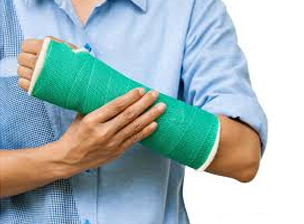
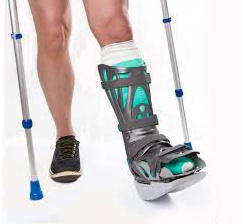
Nonsurgical treatment of fractures :
Many fractures can be treated without surgery. Treatment for these fractures includes casts or splints that can be applied around a fractured limb after the fracture is reduced to limit movement and encourage healing. Casts are very commonly used for mild or moderately severe fractures of the extremities. Once in place, a cast is usually left on for several weeks.
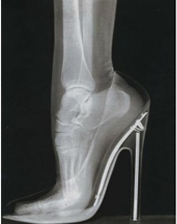
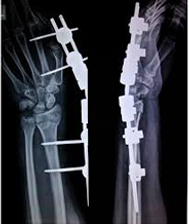
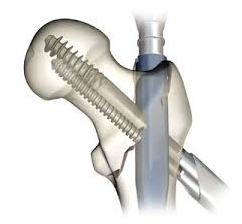
Surgical treatment of fractures :
Many fractures require surgery to repair. Though surgery comes with its own risks, modern orthopedic techniques can lead to improved outcomes. The surgical technique used will depend on the nature of the specific fracture. Some of these techniques include:
» Metal plates may be screwed onto your broken bone to prevent it from moving and to promote healing
» Metal rod may be placed inside the center of a long bone to help reattach two ends of a fracture and to maintain alignment. This technique is called intramedullary fixation
» Pins and rods may be placed in your bones and continue outside your skin, where they can be attached to a metal cage. This technique is known as External fixation and allows for slight adjustments to be made to the orientation and position of a bone as it heals.
What are the potential complications of fractures?

Fractures can range from mild to severe and can result in almost no complications or can result in serious complications. The causeof the fracture, the location of the fracture, and the way the fracture is treated will all affect the potential complications.
Complications of fractures include:
» Infection that can be local or can spread systemically
» Loss of a limb
» Osteomyelitis (bone infection)
» Paralysis resulting from a neck or back fracture
» Permanent deformity
» Permanent loss of sensation
How to reduce the risk of fractures?

There are a number of ways you can reduce your risk of a fracture, though it is impossible to completely eliminate any chance of a fracture.
You may be able to lower your risk of fracture by:
» Following your treatment plan for treatment or prevention of osteoporosis (which may involve calcium and vitamin D supplementation and medications)
» Living a healthy lifestyle with a good diet and lots of physical activity
» Watching young children closely
» Wearing a seatbelt any time you are in a car
» Wearing protective equipment when participating in sports
Nutritional concerns
Persons who consume diets that are rich in calcium are less likely to experience a fracture than those who have diets that are deficient in calcium. Good dietary sources of calcium are milk, cheese, and other dairy products.
Parental concerns
Parents should ensure that their children drink milk to provide an adequate intake of calcium. Children should also participate in regular physical exercise.
:: Sports Injuries ::
Sports medicine, also known as sport and exercise medicine, is a branch of medicine that deals with physical fitness and the treatment and prevention of injuries related to sports and exercise. Although most sports teams have employed team physicians for many years, it is only since the late 20th century that sports medicine has emerged as a distinct field of health care.
What Are Sports Injuries?

The term “sports injury,” in the broadest sense, refers to the kinds of injuries that most commonly occur during sports or exercise. Some sports injuries result from accidents; others are due to poor training practices, improper equipment, lack of conditioning, or insufficient warm-up and stretching.
Common Types of Sports Injuries :
» Muscle sprains and strains
» Tears of the ligaments that hold joints together
» Tears of the tendons that support joints and allow them to move
» Dislocated joints
» Fractured bones, including vertebrae.
What Should I Do if I Suffer an Injury?

Whether an injury is acute or chronic, there is never a good reason to try to “work through” the pain of an injury. When you have pain from a particular movement or activity, STOP! Continuing the activity only causes further harm.
Some injuries require prompt medical attention, so you must see your doctor immediately.
When to Seek Medical Treatment?

You should call a doctor if:
» The injury causes severe pain, swelling, or numbness
» You can’t tolerate any weight on the area
» The pain or dull ache of an old injury is accompanied by increased swelling or joint abnormality or instability
When and How to treat at Home?

If you don’t have any of the above symptoms, it’s probably safe to treat the injury at home—at least at first. If pain or other symptoms worsen, it’s best to check with your doctor.
Use the RICE method to relieve pain and inflammation and speed healing. Follow these four steps immediately after injury and continue for at least 48 hours.
» Rest- Reduce regular exercise or activities of daily living as needed. If you cannot put weight on an ankle or knee, crutches may help.
» Ice-Apply an ice pack to the injured area for 20 minutes at a time, four to eight times a day. A cold pack, ice bag, or plastic bag filled with crushed ice and wrapped in a towel can be used. To avoid cold injury and frostbite, do not apply the ice for more than 20 minutes.
Note: Do not use heat immediately after an injury. This tends to increase internal bleeding or swelling. Heat can be used later on to relieve muscle tension and promote relaxation.
» Compression- Compression of the injured area may help reduce swelling. Compression can be achieved with elastic wraps, special boots, air casts, and splints. Ask your doctor for advice on which one to use.
» Elevation-If possible, keep the injured ankle, knee, elbow, or wrist elevated on a pillow, above the level of the heart, to help decrease swelling.
How Are Sports Injuries Treated?

Immobilization :
Immobilization is a common treatment for sports injuries that may be done immediately
Immobilization involves reducing movement in the area to prevent further damage. By enabling the blood supply to flow more directly to the injury , immobilization reduces pain, swelling, and muscle spasm and helps the healing process begin. Following are some devices used for immobilization:
» Slings, to immobilize the upper body, including the arms and shoulders.
» Splints and casts, to support and protect injured bones and soft tissue. Casts can be made from plaster or fiberglass. Splints can be custom made or readymade. Standard splints come in a variety of shapes and sizes and have Velcro straps that make them easy to put on and take off or adjust.
» Leg immobilizers, to keep the knee from bending after injury or surgery. Made from foam rubber covered with fabric, leg immobilizers enclose the entire leg, fastening with Velcro straps.
Surgery
In some cases, surgery is needed to repair torn connective tissues or to realign bones with compound fractures. The vast majority of sports injuries, however, do not require surgery.
Rehabilitation (Exercise)
A key part of rehabilitation from sports injuries is a graduated exercise program designed to return the injured body part to a normal level of function.
With most injuries, early mobilization—getting the part moving as soon as possible—will speed healing. Generally, early mobilization starts with gentle range-of-motion exercises and then moves on to stretching and strengthening exercise when you can without increasing pain.
When planning your rehabilitation program with a health care professional, remember that progression is the key principle.
Start with just a few exercises, do them often, and then gradually increase how much you do. A complete rehabilitation program should include exercises for flexibility, endurance, and strength; instruction in balance and proper body mechanics related to the sport; and a planned return to full participation.
Who Is at Greatest Risk for Sports Injuries?

If a professional athlete dislocates a joint or tears a ligament, it makes the news. But anyone who plays sports can be injured. Three groups—children and adolescents, middle-aged athletes, and women—are particularly vulnerable.
What Can Groups at High Risk Do to Prevent Sports Injuries?

Anyone who exercises is potentially at risk for a sports injury and should follow the injury prevention tips.
Tips for Preventing Injury :
Whether you’ve never had a sports injury and you’re trying to keep it that way or you’ve had an injury and don’t want another, the following tips can help.
» Avoid bending knees past 90 degrees when doing half knee bends
» Avoid twisting knees by keeping feet as flat as possible during stretches
» When jumping, land with your knees bent
» Do warm-up exercises not just before vigorous activities like running, but also before less vigorous ones such as golf
» Don’t overdo.
» Do warm-up stretches before activity. Stretch the Achilles tendon, hamstring, and quadriceps areas and hold the positions. Don’t bounce
» Cool down following vigorous sports. For example, after a race, walk or walk/jog for 5 minutes so your pulse comes down gradually
» Wear properly fitting shoes that provide shock absorption and stability
» Use the softest exercise surface available, and avoid running on hard surfaces like asphalt and concrete. Run on flat surfaces. Running uphill may increase the stress on the Achilles tendon and the leg itself<

 A fracture, also referred to as a Bone fracture, FRX,FX, Fx or #, is a medical condition where the continuity of the bone is broken.
A fracture, also referred to as a Bone fracture, FRX,FX, Fx or #, is a medical condition where the continuity of the bone is broken. There are several different ways in which a bone can fracture; for example a clean break to the bone that does not damage surrounding tissue or tear through the skin is known as a closed fracture or a simple fracture. On the other hand, one that damages surrounding skin or tissue is known as a compound fracture or an open fracture. Compound or open fractures are generally more serious than simple fractures, with a much higher risk of infection.
There are several different ways in which a bone can fracture; for example a clean break to the bone that does not damage surrounding tissue or tear through the skin is known as a closed fracture or a simple fracture. On the other hand, one that damages surrounding skin or tissue is known as a compound fracture or an open fracture. Compound or open fractures are generally more serious than simple fractures, with a much higher risk of infection.  The period immediately after a bone fracture is critical for the proper repair of the bone and healing of the affected tissues. Bones begin to heal very quickly after a fracture and the bone tissue will knit together with any nearby bone fragments to form a callus of cartilage and eventually new bone tissue.
The period immediately after a bone fracture is critical for the proper repair of the bone and healing of the affected tissues. Bones begin to heal very quickly after a fracture and the bone tissue will knit together with any nearby bone fragments to form a callus of cartilage and eventually new bone tissue. 





 A fracture, also referred to as a Bone fracture, FRX,FX, Fx or #, is a medical condition where the continuity of the bone is broken.
A fracture, also referred to as a Bone fracture, FRX,FX, Fx or #, is a medical condition where the continuity of the bone is broken. There are several different ways in which a bone can fracture; for example a clean break to the bone that does not damage surrounding tissue or tear through the skin is known as a closed fracture or a simple fracture. On the other hand, one that damages surrounding skin or tissue is known as a compound fracture or an open fracture. Compound or open fractures are generally more serious than simple fractures, with a much higher risk of infection.
There are several different ways in which a bone can fracture; for example a clean break to the bone that does not damage surrounding tissue or tear through the skin is known as a closed fracture or a simple fracture. On the other hand, one that damages surrounding skin or tissue is known as a compound fracture or an open fracture. Compound or open fractures are generally more serious than simple fractures, with a much higher risk of infection.  The period immediately after a bone fracture is critical for the proper repair of the bone and healing of the affected tissues. Bones begin to heal very quickly after a fracture and the bone tissue will knit together with any nearby bone fragments to form a callus of cartilage and eventually new bone tissue.
The period immediately after a bone fracture is critical for the proper repair of the bone and healing of the affected tissues. Bones begin to heal very quickly after a fracture and the bone tissue will knit together with any nearby bone fragments to form a callus of cartilage and eventually new bone tissue. 









































